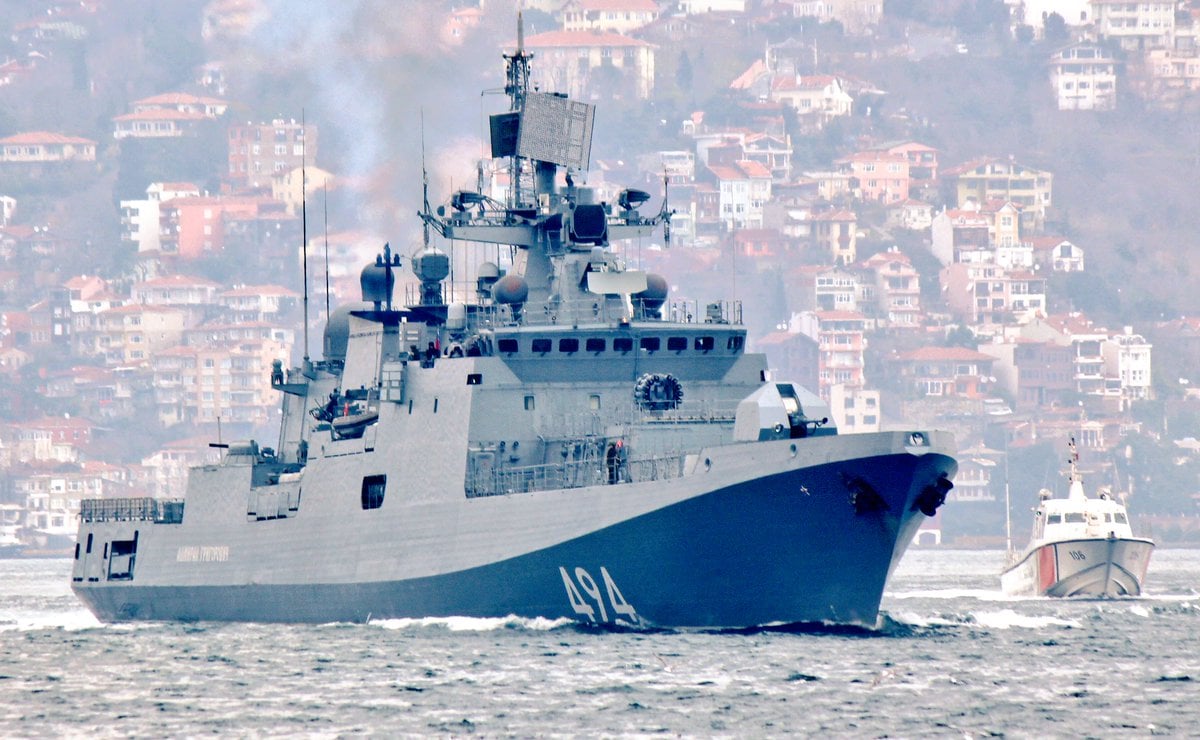Russian Navy Has Limited Role in Initial Invasion of Ukraine
Amphibious warship RTS Olenegorsky Gornyak (012) entering the Black Sea on Feb. 9, 2022. Photo by Yörük Işık used with permission
The Russian Navy acted largely in a supporting role as Russian ground and air assault forces entered Ukraine early Thursday morning in what a senior U.S. defense official called an “initial phase” of the assault against Ukraine.
The Russian force has made a three-axis assault in invading Ukraine, the official said. Forces moved south to north, going from Crimea to the Ukrainian city of Kherson. They moved from the northern central part of the country to the south, with forces coming in from Belarus toward Ukrainian capital Kyiv, and northeast to the south, with more forces from Belarus moving toward Kharkiv, Ukraine.
Russia is targeting population centers, the senior defense official said, with some of the heaviest fighting around Kharkiv. The United States expects that Moscow plans to incapacitate the Ukrainian government in order to install a puppet regime in Kyiv, officials have said.
For its part, the Russian Navy has assembled two amphibious task forces – one in Crimea that could land troops in the vicinity of the major port city of Odessa – and a second in the Sea of Azov that would likely support an offensive at the port of Mariupol.
Over the last month, the Kremlin has flowed six amphibious landing ships into the Black Sea, – assembled from assets in the Baltic and North fleets – joining landing ships already part of the Black Sea fleet.
On Feb. 8, three Ropucha-class tank landing ships – RFS Minsk (127), RFS Korolev (130) and RFS Kaliningrad (102) entered the Black Sea, USNI News reported. The next week, Ropucha-class tank landing ships RTS Georgy Pobedonosets (016), RTS Olenegorsky Gornyak (012) and the more capable Ivan Gren-class RTS Pyotr Morgunov entered the region.
The 4,080-ton Ropucha-class LSTs are each capable of landing 10 main battle tanks and about 350 troops ashore, while the larger 6,600-ton Pyotr Morgunov is capable of landing 13 main battle tanks and 300 troops, as well as field two attack helicopters.
In total, the Russians have a force of 10 amphibious ships, U.S. defense officials have said.
Russia did not use amphibious ships for landing operations in the beginning phase of the invasion, a senior defense official told reporters.
“We still have no evidence of Odessa right now being occupied or attacked,” the official said Thursday afternoon.
Unlike the U.S. Marines, Russian amphibious forces don’t train for contested amphibious landings and would drop off troops to reinforce an area that was already under control, or move behind Ukrainian lines to attack.

Admiral Grigorovich on March 1, 2017. Bosphorus Observer photo used with permission
“If the ground offensive is slowed, an amphibious landing behind the Ukrainian front lines becomes an option. The Ukrainian military has to hedge against that possibility, diluting them further,” former NATO Supreme Allied Commander Adm. James Stavridis told USNI News on Thursday.
As of Thursday morning, the Russian Black Sea fleet has largely supported the Russian ground and air assault troops that have struck near the capital of Kyiv from Belarus and the city of Kherson with forces from Crimea.
“The Russian Black Sea fleet is essentially a holding force directed against the Ukrainian military south of Ukraine. Assuming Putin’s ground offensives don’t bog down – which will depend on the quality of Ukrainian resistance – they will probably limit their participation to surface-to-surface missile strikes,” Stavridis said.
A U.S. defense official told USNI News that Russian Navy surface ships in the Black Sea fired the long-range Kalibir NK land-attack missiles. The Russian Navy bases Steregushchiy-class corvettes in the Black Sea. The 2,200-ton guided missile corvettes are “designed for operations in adjacent maritime zones, fighting enemy surface ships and submarines, as well as to provide naval gunfire support for amphibious landings,” according to a U.S. Office of Naval Intelligence report.
The Russian Navy also has a fleet of Kilo-class submarines in the Black Sea capable of firing Kalibirs.

![DVIDS – Images – 11th MEU Marines, Sailors Conduct CRRC Training Aboard the USS Boxer [Image 1 of 8] DVIDS – Images – 11th MEU Marines, Sailors Conduct CRRC Training Aboard the USS Boxer [Image 1 of 8]](https://101veterans.com/wp-content/uploads/2024/12/dvids_logo_20_main.png)